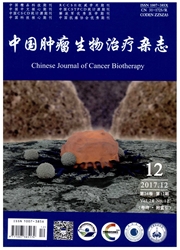

 中文摘要:
中文摘要:
目的:建立γ射线辐射诱导支气管上皮细胞恶性转化模型。方法:永生化人支气管上皮细胞BEAS-2B经总剂量22Gy^60Coγ射线分3次照射后进行传代培养,应用平板克隆实验、血清抗性实验、细胞软琼脂集落实验检测该细胞系恶性程度;裸鼠皮下种植辐射细胞检测其成瘤能力,成瘤组织H-E染色及免疫组化进行病理学观察。结果:(1)平板克隆实验表明照射细胞培养至35代后其增殖能力明显增加(P〈0.05或P〈0.01),血清抗性实验显示照射组细胞在第45代后克隆形成增加(P〈0.01),而在照射后50代细胞软琼脂集落的形成能力明显增加(P〈0.01),显示BEAS-2B细胞经辐射后出现了恶性转化。(2)皮下种植22Gy 50代细胞的8只裸鼠50d后1只成瘤,种植22Gy 60代辐射细胞的8只裸鼠中有4只成瘤;成瘤组织病理检测及免疫组化证实为上皮细胞癌。结论:成功地建立了^60Coγ射线诱导的支气管上皮细胞恶性转化模型。
 英文摘要:
英文摘要:
Objective : To establish a malignant transformation model of human bronchus epithelium cells (BEAS-2B) by ^60Co γ-ray irradiation. Methods: Immortalized BEAS-2B cells were subjected to a irradiation with ^60Co γ-ray for three times, with a total dose of 22 Gy. Then the cells were cultured and subjected to colony-forming test, serum antibody experiment, and colony formation experiment in soft agar to detect the level of cellular malignant transformation. Nude mice were implanted subcutaneously with radiated cells to examine the tumor-forming ability of the irradiated cells; the formed tumor tissues were stained with H-E and immunohistochemistry methods for pathology observation. Results: (1) Colonyforming test showed that the proliferation ability of the cells was significantly increased after the 35th passage after 22 Gy radiation (P 〈0.05 or P 〈0.01 ) ; serum antibody experiment demonstrated that the colony forming ability was increased at the 45th passage after irradiation(P 〈0.01 ) ; and in the soft agar colony formaing experiment, colony forming ability of the 50th passage cells was increased significantly(P 〈0.01 ). All the above 3 test indicated the malignant transformation of BEAS-2B cells after irradiation. (2) Eight nude mice were implanted with the 50th passage cells after irradiation, and one mice had tumor formed at the nape 50 days after implantation; another 8 nude mice were implanted with 60th passage cells and 4 mice had tumor formed. Pathological observation indicated the formed tumor was epithelial cell carcinoma. Conclusion: We have successfully established the malignant transformation model of human bronchus epithelium cells (BEAS-2B) by ^60Co γ-ray irradiation.
 同期刊论文项目
同期刊论文项目
 同项目期刊论文
同项目期刊论文
 期刊信息
期刊信息
